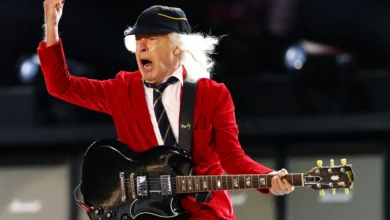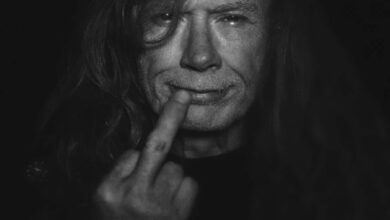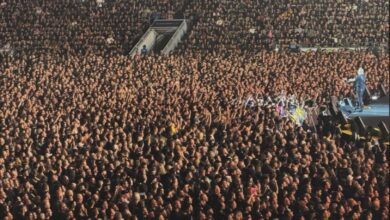The night AC/DC unleashed “If You Want Blood” and “Thunderstruck,” shaking Melbourne harder than ever at the MCG
On November 12, 2025, the Melbourne Cricket Ground became something more than a venue—it became the epicenter of a cultural detonation. Hours before AC/DC hit the stage, the stadium vibrated with a tension that only a decade-long wait could produce. Fans in devil horns, vintage tour shirts, and brand-new merch filled the grounds with a buzzing electricity that felt almost dangerous. Everyone sensed that the night would be one for the history books, and what they didn’t yet know was that it would grow even larger: the intro, the opening song, and the eventual eruption of “Thunderstruck” would collectively push the MCG into such chaotic motion that the earth itself recorded it.
The entire city of Melbourne had spent the day preparing for the homecoming of its loudest and most legendary export. Federation Square overflowed with hundreds of bagpipers blasting “It’s a Long Way to the Top,” sending soundwaves bouncing through tram lines and laneways like an early warning signal. AC/DC Lane became a pilgrimage site. Pop-up merch stores did the kind of business usually reserved for championship celebrations. By the time thousands poured toward the MCG, it felt less like a concert crowd and more like a tidal wave of anticipation headed toward a single point on the map.
Inside the stadium, the stage rose like an industrial cathedral—massive steel structures, towers of lights, and LED screens wide enough to swallow the entire field in fire and color. Roadies performed final checks as anxious cheers periodically roared through the crowd. Fans shifted from foot to foot, calling out predictions about the opening song. Every flicker of the house lights sent adrenaline spikes through tens of thousands. The PA teased classic rock deep cuts, each one pushing the already frantic atmosphere a little closer to combustion.
Then, without warning, the stadium plunged into total darkness. Not a gradual fade—an instant, absolute blackout that made the entire arena scream as if struck by lightning. A bass-heavy rumble rolled through the PA, deep and primal, building like a thunderstorm forming in slow motion. Red and white lights flashed across the screens, forming cryptic symbols and spirals that made the stadium feel like the center of a ritual. The intro didn’t simply begin; it took over the entire space, wrapping 80,000 people in tension so thick you could practically feel the air tighten.
As the intro deepened, something strange began happening underfoot. Fans felt a faint, eerie vibration rising from the stadium’s foundation. Stomping, jumping, and the sheer low-frequency power of the PA created waves that crawled up through the concrete, slightly shaking seats and railings. In the moment, everyone assumed it was adrenaline or bass. They didn’t yet know seismic monitors around the city were picking up the activity. The MCG wasn’t just alive—it was physically trembling, and every second of the intro amplified that movement.
A sudden explosion of white light revealed silhouettes that instantly sent the crowd into delirium. Angus Young in full schoolboy regalia, SG slung low and ready. Brian Johnson stepping forward with that unmistakable cap pulled down tight. Stevie Young, Chris Chaney, and Matt Laug lining up behind them like a well-oiled war machine. For one suspended moment they held still, letting the volume of the stadium wash over them. Only a band with AC/DC’s history could command silence and chaos at the same time through nothing but presence.
And then the night truly ignited. Angus tore into the opening riff of “If You Want Blood (You’ve Got It)” with a ferocity that felt like a defibrillator shock straight to the heart of the stadium. Red lights flooded the stage, Brian Johnson lunged into the first verse with a voice that sounded sharpened by time instead of softened by it, and the crowd detonated. Fists shot into the air, thousands of voices instantly synced to the lyrics, and the MCG transformed into a roaring mass of rhythmic movement. The ground beneath fans’ feet pulsed harder, fed by the power of the song and the crowd’s violent enthusiasm.
Brian Johnson’s performance was a lesson in endurance and grit. At 78, he stalked the stage with the swagger of a man born for loud rooms and unforgiving riffs. His voice—rough, explosive, unmistakable—cut through the night with shocking authority. Angus darted down the runway in a frenzy of duck-walking, bending notes, and unleashing the kind of solo that only he could deliver. “If You Want Blood” wasn’t merely an opener; it was an attack, a reclaiming of a stage AC/DC had spent half a century earning.
The generational mix of the crowd added an emotional weight to the moment. Teens and twenty-somethings screamed with youthful awe, many seeing AC/DC live for the first time. In contrast, those who had followed the band for decades mouthed the lyrics like a pledge renewed. The anthem became a unifying force—an intergenerational handshake delivered at stadium-shaking volume. From the stands to the floor, the MCG moved like one living organism driven by the power of a single riff.
As the song surged through its solo section, Angus moved like a man possessed, hopping, spinning, and attacking his guitar with relentless fire. The LED screens showed his fingers flying across the fretboard, sweat pouring under the stage lights. The production intensified with bursts of strobe lights and waves of red visuals that made the stage look like a molten core. The crowd responded with unfiltered abandon, moving, shouting, and stomping with such force that the tremors underfoot built into something unmistakable: the stadium was shaking.
Then it was time for the next escalation—the moment everyone felt brewing since the blackout. As the last note of “If You Want Blood” echoed through the arena, Angus stepped forward alone under a cool blue spotlight. He paused, lowered his head, and began picking the opening notes of “Thunderstruck.” The crowd’s reaction was instantaneous and volcanic. The familiar, electrifying guitar pattern sliced through the night with surgical precision, and the MCG went absolutely ballistic. The floor rippled with motion. Entire sections bounced in unison. Fans screamed the intro melody so loudly that their voices intertwined with the guitar. The stadium-wide movement intensified the vibrations, pushing the ground shaking from “noticeable” to “unbelievable.”
“Thunderstruck” is not just a fan favorite—it is a cultural weapon. As Angus hammered out the relentless riff, Brian Johnson reemerged with his fist raised high. When he roared “THUN-DER!” for the first time, the stadium answered with a deafening “STRUCK!” that shook railings and rattled seats. The sky above the stadium flashed with lighting bolt animations, and blue-white strobes hit the crowd like shockwaves. The energy inside the MCG during this song was so overwhelming, so physically forceful, that the stadium quite literally trembled. Fans would later joke that Melbourne experienced a “rock ’n’ roll earthquake,” but the truth was even better: seismic equipment genuinely picked up the activity.
“Thunderstruck” turned the concert into a full-blown seismic event. The pogo-like movement of tens of thousands synced perfectly with the song’s relentless beat, creating jump cycles that traveled through the grandstands like synchronized tremors. Drinks spilled. Camera footage shook. People grabbed onto their friends not out of fear, but out of amazement. Angus’s fingers kept firing like electrical sparks, Brian’s voice boomed with unstoppable power, and the rest of the band delivered a rhythmic assault strong enough to push the venue toward its structural limits. It was the kind of moment stadiums are not designed for—but AC/DC had always played beyond design.
By the time “Thunderstruck” reached its final chorus, every inch of the stadium buzzed with kinetic energy. Angus ended the song in a whirlwind of movement, spinning, bending, and unleashing rapid-fire runs across the fretboard. The roar that followed was the loudest of the night—a mixture of awe, disbelief, and pure ecstatic release. After two songs, AC/DC had already delivered what most bands would save for an encore. The crowd was breathless, stunned, and euphoric, yet the band looked like they were only just getting warmed up.
After “Thunderstruck,” the band surged directly into “Back in Black,” refusing to let the crowd catch even a moment of rest. But the earlier songs—the intro, the opener, and “Thunderstruck”—had already carved themselves into Melbourne history. Those moments became the gravitational center of the night, scenes people would replay in their minds long after the final note faded. The combination of nostalgia, intensity, and raw physical force created an opening sequence unlike anything the MCG had ever hosted.
When fans poured out of the venue afterward—sweaty, hoarse, stunned—they knew they had witnessed more than a concert. They had been part of a phenomenon. The earthquake-like tremors became instant legend, the opening songs became stories people would tell for years, and the energy of “Thunderstruck” became the defining pulse of the night. Melbourne didn’t just host AC/DC. Melbourne shook, roared, and reverberated with them.
On November 12, 2025, AC/DC didn’t simply return to their home country.
They arrived like a lightning strike.
They shook the ground like a seismic wave.
And with the power of “Thunderstruck,” they delivered one of the greatest, loudest, and most physically explosive performances Australia has ever seen.





